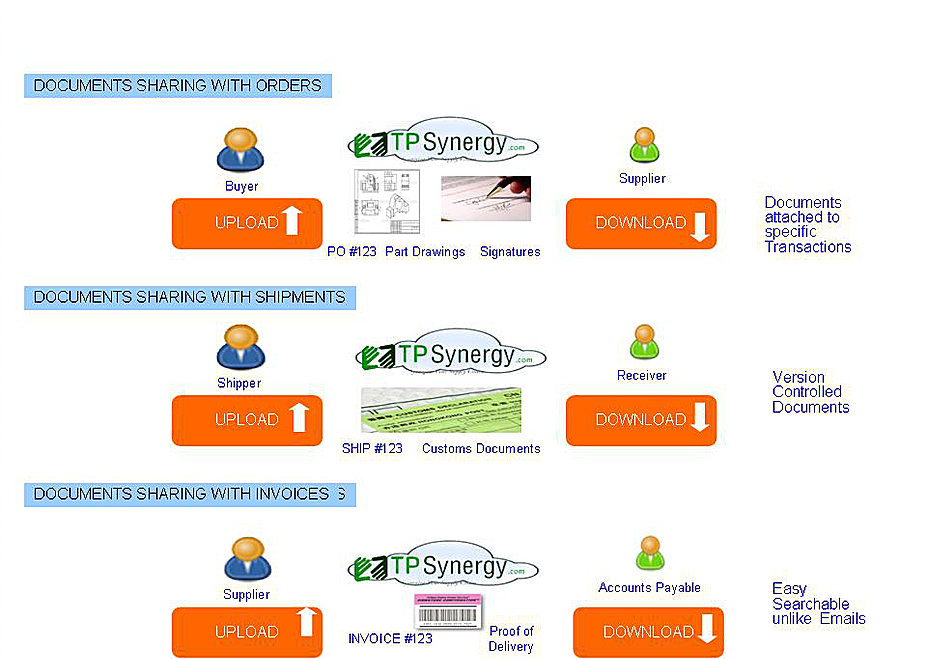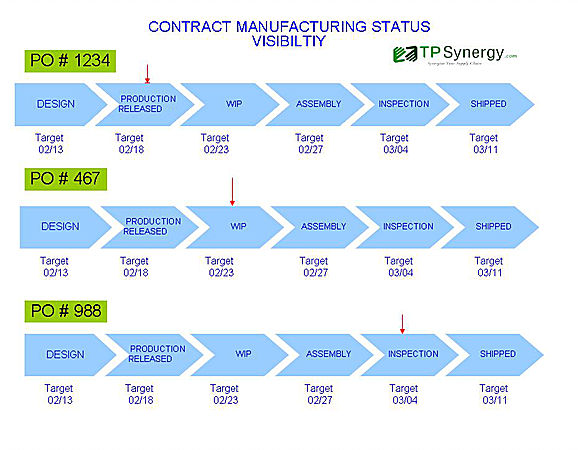Supply Chain Collaboration Explained
Collaboration Areas
 There are many areas of collaboration in Supply Chain. Below are common areas that needs collaboration
There are many areas of collaboration in Supply Chain. Below are common areas that needs collaboration
- Purchase Orders
- Shipments/Receipts
- Inventory/ Forecast
- Invoice/Payments
Purchase Order Collaboration
 Typical scenarios that need supply chain collaboration in purchasing are
Typical scenarios that need supply chain collaboration in purchasing are
- Small group of Strategic suppliers – Mostly 75-300 suppliers. Most of the items are single or dual sourced
- Frequent small volume purchase orders to the same suppliers. Generally, 2-3 purchase orders for the same items to the same suppliers every month
- Frequent Revisions to Purchase orders – Expedite, Delay or Cancel. This is due the changes suggested by MRP after demand fluctuation.
Purchase Order Life Cycle Management
- How purchase orders are confirmed by the suppliers. Are the supplier confirmations recorded in any system?
- How suppliers request for changes. How are these changes processed? Are they handled manually
- How suppliers are informed of the changes. Expedite, Delay and Cancel. How are they communicated to suppliers?
- How order status is tracked. Open orders, delayed orders, old orders – how are they managed
Shipments/ Receipts Collaboration
 Advance Shipment Notice:
Advance Shipment Notice:
- Do Suppliers provide advance notice of the inbound shipment
- Is the Advance shipment notice provided electronically – for example, EDI or other electronic means?
- Is the Advance Shipment Notice detailed enough with all package details, serial numbers, lot number, expiration dates etc.
 Shipments Tracking
Shipments Tracking
Are the shipments tracked from the time it is shipped till it reaches the warehouse. There are many cases where the shipment is stuck or delayed in-transit and it was not monitored. Supply chain managers wake up and start checking the shipment status when the material does not arrive in time and production comes to a standstill.
Receiving Process at the Warehouse
 When the material is received at the warehouse, it might take lot of time to verify all the contents, match it to the order. But if an Advance Shipment Notice (ASN) was received electronically earlier, it might be lot easier and faster at the time of receiving material.
When the material is received at the warehouse, it might take lot of time to verify all the contents, match it to the order. But if an Advance Shipment Notice (ASN) was received electronically earlier, it might be lot easier and faster at the time of receiving material.
If there are shortages/quality issues on material received, how do the suppliers are informed of the shortages. Is there a system to track shortages and quality issues correction requests
Do suppliers send wrong shipments? Wrong purchase order numbers or wrong items in the delivery will delay receipts and may make the material not available for production.
Invoice Collaboration

Emotional stress.
If suppliers are sending manual copies of invoices or sending as pdf attachments to email, it still is lot of manual work. Matching the invoice to the purchase orders and receipts needs effort. Two ways and Three way matching are required before the invoices can be processed for payment.
Using an electronic version of invoices like EDI or XML will lead to increased collaboration on improving the efficiency of invoices management.
Forecast Collaboration

Budget maybe.
Forecasts provide a sneak peek into the future demand for the suppliers. Sharing the buy plan or forecast well in advance with the supply chain network will reduce lead time as the Supply chain is already aware of the coming demand and is willing to stock certain amount of the demand with short notice.
Sharing the forecast with the Supply chain network must be done periodically on a regular basis. Most of the companies follow a 52 weeks rolling forecast model to keep the supply chain aware of the derived demand based on the end items demand.
Also, it is a good idea to get the feedback from the supply chain regarding this demand forecast. Does the supply chain have the capacity to meet this demand? Are the suppliers preparing for the spikes in demand by adding capacity? Also, if one of the source is not able to meet the demand, it is better to take this information back to the MRP and re allocate the demand to another source that is able to meet the demand.
The Forecast sharing, and capacity commits from the suppliers improves the MRP cycle in the long run.
Inventory Collaboration

VMI – Manufacturer Benefits
As all manufacturers are driving to reduce the inventory, VMI – Vendor Managed Inventory is becoming more and more popular. Manufacturers are pushing the inventory down the supply chain and expecting the suppliers to keep adequate stock on behalf of them and deliver at very short notice. Suppliers maintain inventory at an arm’s length of the manufacturing unit and pull signals enable delivery at very short notice.
Service Level Agreements (SLA) are to be in place for the amount of stocks to be maintained by the suppliers and the ownership of the material. What happens when the material is not consumed by end of a certain period. Does the ownership transfer to the manufacturer from the suppliers? These are certain terms and conditions to be laid out for an effective VMI arrangement.
How the Demand signals (pull signals) are communicated to the suppliers. How periodical reconciliation of replenishment transactions are done will determine the success of the VMI program.
Kanban or Just in Time (JIT) is another area of inventory collaboration. This process will need a tighter collaboration between manufacturers and suppliers as the demand is communicated at a very short notice and need to be fulfilled immediately. Electronic Kanban or E-Kanban enables more effective inventory collaboration in this area.
Cloud Solution for Collaboration
 Using a cloud solution like TPSynergy
Using a cloud solution like TPSynergy
enables an effective collaboration process in place for the supply chain.
All the above supply chain process is well defined and established in a system manner. Following the process and getting collaboration benefits are easier by using a cloud collaboration platform like TPSynergy supply chain collaboration platform




Leave a Reply